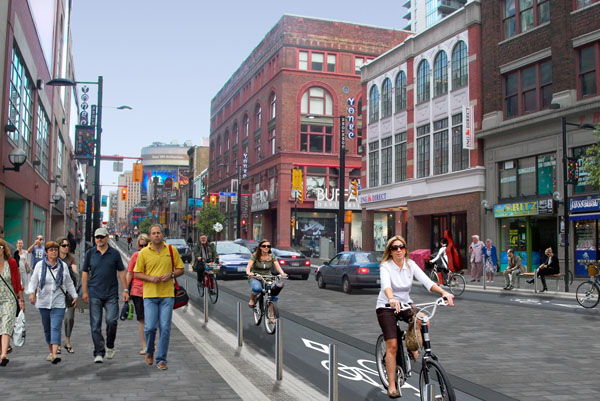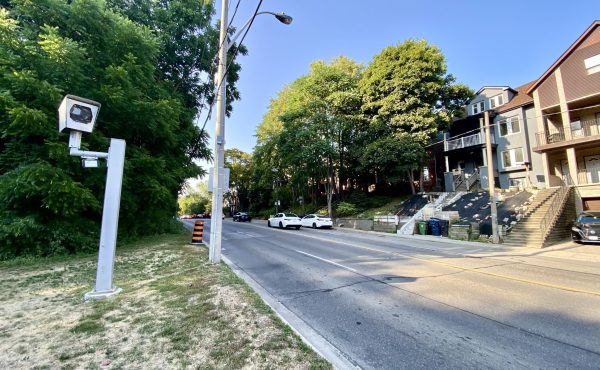If there’s one thing I learned from the 2013 Complete Streets Forum this week, it was that we in Toronto need to learn to market our city’s accomplishments better, to outsiders but, more importantly, to ourselves. Three of the plenary speakers at this annual conference organized by the Toronto Centre for Active Transportation (TCAT) were heads of the Transportation division in other cities — San Francisco, Chicago and Vancouver. Each of them gave the impression that their city was dynamic and engaged in exciting and innovative new sustainable transportation initiatives, some completed but others still in the planning phases.
They are indeed, of course, but if you think about it, so is Toronto, despite our current political crisis. For example, the transformation of Queen’s Quay into an attractive, dedicated walking/cycling/transit route is well underway — the very model of a complete street. It’s as remarkable as any of the other plans I saw in other cities — but I didn’t hear a single person mention it all day. It may be driven by Waterfront Toronto more than the City, but it’s still Toronto.
Gabe Klein, head of Transportation for Chicago, told a story about his time in the same position in Washington DC. One night, as part of political manoeuvering, the city council cut funding for the city’s first streetcar project, already underway. Within a day every member of council’s phone was ringing off the hook from outraged citizens — because the project’s proponents had devoted time to selling the idea to citizens and getting them excited about the project (Klein is a former marketer). Funding was quickly restored. Contrast that with the ineffective selling of the LRT projects by Mayor Miller and City and TTC staff — a lack of engagement that made it easier for the projects to be thrown into jeopardy by the next administration.
The lesson I heard is, it’s not enough to do good things in a city, you need to tell people you are doing them and get people excited about them. And you need to frame the good things you’re doing as part of an overall vision or strategy so people understand where the city is going.
There were lots of other interesting insights at the conference, too.
- Toronto’s new General Manager, Transportation, Stephen Buckley, led the creation of Complete Streets guidelines in Philadelphia. He emphasized that, while they are conceived as “guidelines” to preseve flexibility, if anyone wants to deviate from the guidelines they need to justify exactly why. This approach would be a good example for Toronto’s many policy “guidelines”, which seem to be often ignored.
- In the US, the National Association of City Transportation Officials is developing a set of standards for city streets (PDF) so that their traffic engineers will stop using suburban standards for streets in urban areas.
- Vancouver used the 2010 Winter Olympics as a test run for developing their next transportation strategy. Transit and walking, which could be scaled up rapidly, are what made it possible to manage the crowds. They also took the time to partner with UBC to do a post-mortem of lessons learned (note to Toronto re. the Pan-Am games)
- Vancouver has a brilliant idea to solve the problem of pedestrians and cyclists getting over the long, hostile Granville Bridge and its off-ramps — put a greenway in the middle of the bridge, which will bring people right into the city.
- Vancouver learned, when discussing transportation mode share, not to use pie charts (which make it look like cars are losing out), but bar charts, so drivers can see the number of car trips is not going down much, but rather there are many new additional trips being done by walking, cycling and transit.
- Several cities have already set up programs where local businesses pay to create “parklets” — permanent mini parks in parking spots (for example, providing a nice bench or some greenery). I hope Toronto will soon also provide a simple process to create these too.
- In a session on transforming suburban streets, we heard a story from Ajax. Staff noted that a fence around a GO station kept getting cut because it was the most direct walking route for some people. Instead of repairing the fence, they took it down, created a path, and added a pedestrian crosswalk to access it.
- The requirement to build suburban streets to modern safety standards (e.g. for fire trucks) is creating a serious speeding problem in new suburbs, and continuous demand for additional traffic calming measures.
- “Green Active Health Neighbourhoods” is a great program in Montreal working with communities to make them more walking and cycling friendly. TCAT and Toronto Public Health are collaborating to bring this process to Toronto.
- When talking about transportation costs, we should include the private cost of running private cars. It’s many times larger than the public cost of transportation.
- San Francisco has developed an explicit strategy for coping with the expanded demand on transportation resulting from new development. As part of it, the city charges developers a fee for expanding public transportation to cope with the new residents or employees they will bring to the city.
- San Francisco is focusing on redesigning streets to reduce speeds — starting with the most dangerous streets for pedestrians.
- San Francisco developed a “Level of Traffic Stress” measure for cycling to identify locations that served as a deterrent to cyclists. It revealed the hidden fragmentation of their bike network, and where they needed to make interventions to make cyclists feel comfortable and safe so they could make a continuous journey.
- Metrolinx will be giving 5% of its revenues (if it gets them) to municipalities for non-transit/road mobility projects — largely walking and cycling. That potentially means $100 million or more a year in the GTHA, which could make a big difference.
- All new and reconstructed bridges in Mississauga include barrier-protected walking and cycling facilities. That should be a standard across GTHA.
- Chicago has a website that features all of their new and planned projects.
- Chicago has a goal of zero pedestrian fatalities in 10 years. To be accomplished through education, engineering, and automated enforcement (read: red light cameras).
Image from Complete Streets for Canada.





3 comments
Thanks for the great summary Dylan, so much excellent stuff here!
And regarding converting parking spots into parklets, they are coming to TO this summer: last month the Church Wellesley Village BIA approved a test program for spots along Church Street for July & August. (Hopefully the rest of the city will be taking notes!)
http://www.xtra.ca/public/Toronto/Goodbye_parking_hello_green_spaces-13409.aspx
The issue is that the city needs a comprehensive transportation policy, where adding bike lanes and sidewalks is SOP rather then a process that makes getting a zoning variance look easy. For example, when a street is resurfaced/rebuilt, the default is a sidewalk on one side, if traffic is above a certain level it gets two sidewalks. Above another level it is marked for sharrows, above still another level and it is marked for bike lanes. These traffic levels should be below those where you would normally move to 4 traffic lanes. Yes it means that some streets might be redone to 2 traffic lanes and 2 bicycle lanes, where they were 4 traffic lanes before. Within 30 years all streets that need them, would have bicycle lanes.
Easier and better, make the city speed limit 30km/h.
Toronto’s city council considers requests to form relationships with other cities through its International Alliance Program. The criteria for both Partnership Cities and Friendship Cities were adopted by council December 5–7, 2005. Forming a relationship is primarily dependent on budget constraints of the Economic Development Committee, the municipal office which administers the program.